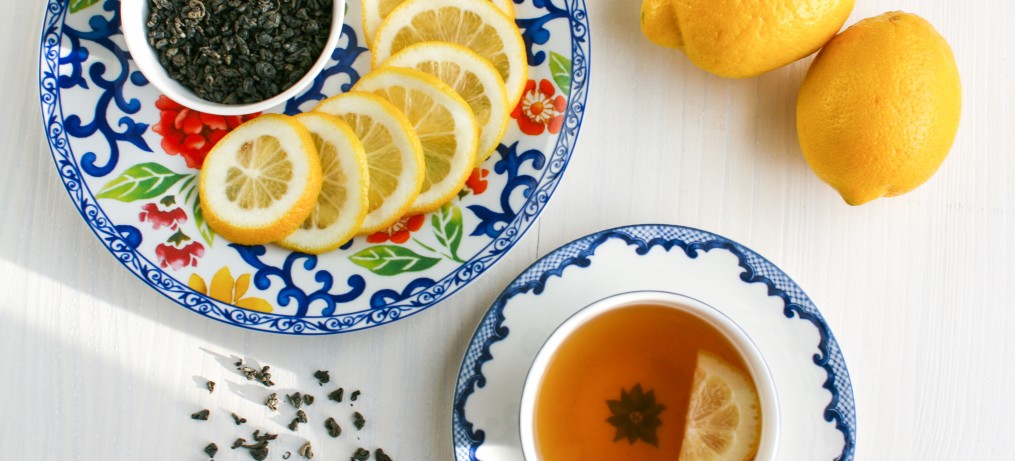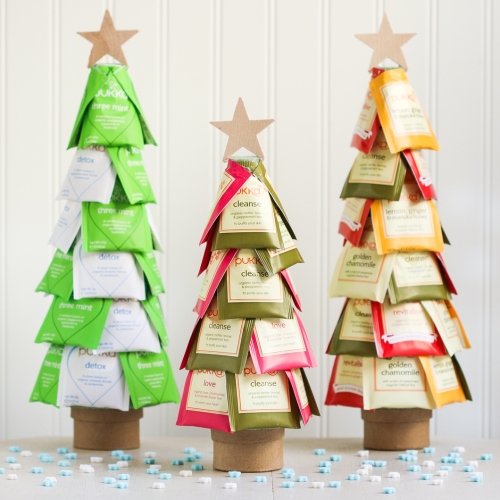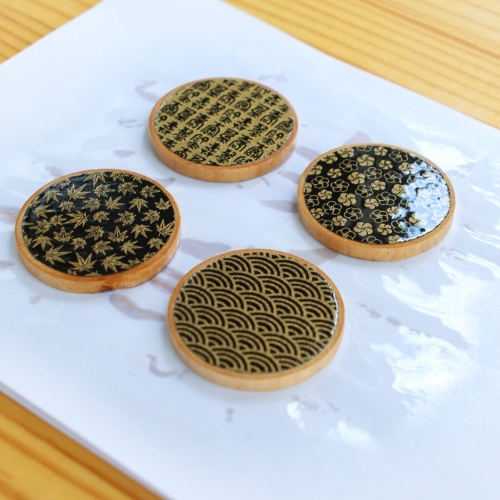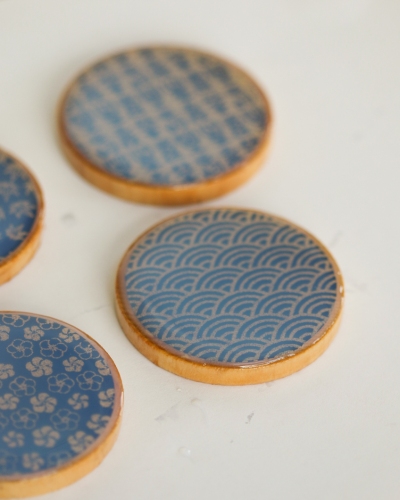 Just like that and Christmas is tomorrow! The last week has been so utterly hectic. Last minute trips to the mall, mad gift wrapping, and anxiously waiting for the UPS guy to show up with my deliveries has left me in serious need of a tea break. I’m sure you could use a break too, so here is my offering to you during this eventful holiday season: a Gingerbread Teacup–quaint and cozy–just in time for time for the big day tomorrow.
Just like that and Christmas is tomorrow! The last week has been so utterly hectic. Last minute trips to the mall, mad gift wrapping, and anxiously waiting for the UPS guy to show up with my deliveries has left me in serious need of a tea break. I’m sure you could use a break too, so here is my offering to you during this eventful holiday season: a Gingerbread Teacup–quaint and cozy–just in time for time for the big day tomorrow.
 Last week I made a gingerbread house for my niece Maddy. With the spicy dough, I created heart-shaped windows, a deeply sloped roof, and a slender chimney that you could almost imagine smoke whispering out of. That’s the thing about gingerbread…it’s like playing with molding clay–ideal for those who like creating art out of food. The whole process got me thinking of how to shape gingerbread, especially since I’ve been meaning to finally put my brand new Sports Ball Pan Set to use. Sports ball? We can do better than that!
Last week I made a gingerbread house for my niece Maddy. With the spicy dough, I created heart-shaped windows, a deeply sloped roof, and a slender chimney that you could almost imagine smoke whispering out of. That’s the thing about gingerbread…it’s like playing with molding clay–ideal for those who like creating art out of food. The whole process got me thinking of how to shape gingerbread, especially since I’ve been meaning to finally put my brand new Sports Ball Pan Set to use. Sports ball? We can do better than that!
 What’s great about the Sports Ball Pan is that it’s divided into 2 hemispheres, the perfect depth for a deep yet shallow teacup. To combat the gingerbread dough’s tendency to want head south while baking (because of the molasses and butter in the dough), I freeze the shaped tea cup dough before baking it. I also use the other empty hemisphere of the mold to compress the dough from the top to help create an even thickness along the lip of the cup. For maximum versatility, it’s also important to use a dough recipe that can tolerate some cutting with a serrated knife after being baked.
What’s great about the Sports Ball Pan is that it’s divided into 2 hemispheres, the perfect depth for a deep yet shallow teacup. To combat the gingerbread dough’s tendency to want head south while baking (because of the molasses and butter in the dough), I freeze the shaped tea cup dough before baking it. I also use the other empty hemisphere of the mold to compress the dough from the top to help create an even thickness along the lip of the cup. For maximum versatility, it’s also important to use a dough recipe that can tolerate some cutting with a serrated knife after being baked.
 After baking off the tea cup piece, you’ll notice that the inside bottom of the teacup is thicker than the sides. This is simply a result of gravity doing its work during baking, so don’t worry! The cup is designed to be filled with lots of small edible goodies, so a thicker base means a sturdier base.
After baking off the tea cup piece, you’ll notice that the inside bottom of the teacup is thicker than the sides. This is simply a result of gravity doing its work during baking, so don’t worry! The cup is designed to be filled with lots of small edible goodies, so a thicker base means a sturdier base.
I’ve also tinted my royal icing with cocoa powder and cinnamon so that it looks like the color of the dough itself. This isn’t typical in gingerbread house making, but a good idea here since we want the tea cup pieces to come together to look continuous and smooth. The cocoa colored icing is used to attach the rim of the tea cup, which is simply made from creating a ring of gingerbread dough based on the diameter of the sphere.
 My sweet friend Danielle from This PictureBook Life bought me some yummy little Green Tea Kit Kats when she stopped over at Hello Kitty Con in Little Tokyo, so I thought this would be the perfect time to use (and eat!) them. You could certainly make your own tea-infused treats like Homemade Green Tea Pocky or Lemon Matcha Cake Bites, but if you’ve already made the cup, you should probably take a break now.
My sweet friend Danielle from This PictureBook Life bought me some yummy little Green Tea Kit Kats when she stopped over at Hello Kitty Con in Little Tokyo, so I thought this would be the perfect time to use (and eat!) them. You could certainly make your own tea-infused treats like Homemade Green Tea Pocky or Lemon Matcha Cake Bites, but if you’ve already made the cup, you should probably take a break now.
Truffles, biscuits, or even a pile of individually wrapped tea bags will steal the show in this homey little cup. Gingerbread Tea Cups: drink the tea, eat the cups! I’ll be taking this treat display over to my UK blogger friend Justine’s site for her Special Christmas Tea Time this week–you should come too! And with this post, I’d like to wish you a very Merry Christmas and send out a big thank you for following me along on my tea adventures this year! Happy Holidays everyone!!
Gingerbread Teacups
Makes 2 cups.
Ingredients:
{Gingerbread Dough}
1 cup unsalted butter, at room temperature
1 1/4 cups light brown sugar
2 eggs, at room temperature
2 tsp fresh ground ginger
2 tsp vanilla extract
1 cup molasses
2 tsp cinnamon
2 tsp ground ginger
1/2 tsp cloves
1 tsp baking soda
1/2 tsp salt
5 cups all-purpose flour
bench flour
{Royal Icing}
1 1/2 sifted confectioner’s sugar
2 Tbsp sifted cocoa powder
2 tsp cinnamon
2 tsp powdered egg whites
2 Tbsp water
{Embellishments-optional}
small piece of red fondant
small heart-shaped cookie cutter
candies or cookies for filling the tea cup (I used green tea Kit Kats)
sugar cubes
teaspoons
Equipment:
stand mixer with paddle attachment
rubber spatula
large mixing bowl
large work surface
rolling-pin
sharp knife
ruler
7″ plate or other circle to use as template
large baking sheet fitted with parchment
large spatula, for handling hot gingerbread
cooling rack
sports ball baking pan, sprayed with non-stick spray on the inner surface of one hemisphere, and the outer surface of the other hemisphere
serrated knife
medium mixing bowl
plastic piping bag
scissors
Directions:
1.) Make the Gingerbread Dough. Cream butter and sugar together in the bowl of stand mixer on low. Meanwhile mix the cinnamon, ground ginger, cloves, baking soda, salt, and flour together in a large bowl. Add eggs, one at a time, to the creamed butter, mixing thoroughly after each addition. Use a rubber spatula to scrape down the sides of the bowl, then add the fresh ground ginger, vanilla, and molasses and continue to mix on low. Gradually add the spiced flour to the creamed butter until the dough is thoroughly mixed together. Place the dough on a large piece of plastic wrap, slightly flatten and seal tightly, then place the dough in the fridge to chill for at least 2 hours before rolling.
2.) Shape the Teacup. After the dough has chilled, divide it in half, then roll one piece of the dough out to 1/8″ thickness with a rolling-pin on a large work surface generously dusted with flour (leave the other half covered in plastic wrap in the fridge). Roughly cut out a 10″ circle, then gently lay this piece of dough into one half of the ball baking pan (the hemisphere with the inner surface greased). Fit the dough into the pan as if you were laying pie crust into a pie plate, making sure the dough fits snugly and evenly against the ball pan. If there are tears, carefully patch them with scraps of dough. Trim off excess dough laying over the edge of the pan with a sharp knife. Place the mold fitted with the dough into the freezer to freeze until solid.
3.) Create a Handle. Cut out a 1/2″ by 5″ strip of dough from the rolled dough. Shape it into the shape of a half heart, then place it on a large baking sheet.
4.) Create a Tea Cup Rim. Cut out a 6″ round (using the empty hemisphere), then cut out a 5 1/2″ circle inside of the dough cut-out, creating round ring. Carefully transfer this dough ring to the baking sheet.
5.) Create a Plate. On the rest of the rolled dough (or scraps re-rolled to 1/8″ thickness), place a 7″ plate. Cut around the plate with a sharp knife to create a gingerbread plate. Transfer this 7″ round of dough also to the large baking sheet. Lightly press the bottom of one of the ball molds into the center of the round to create a “ditch” for the teacup to sit in later. Place this plate also on the baking sheet.
6.) Bake Cup, Handle, Rim, and Plate. Pre heat oven to 375 degrees F. When the oven comes to temperature, Place the dough teacup into the oven, with the other greased half of the mold (the empty hemisphere, greased on the outside) pressed snugly against the top surface of shaped dough. This will help the dough to create stronger “sides” on the teacup. Bake the shaped teacup dough for about 15 minutes, then remove the top pan and bake for an extra 12-15 minutes until the gingerbread is slightly puffed and stiff to the touch. Bake the handle, teacup rim, and plate for about 10 minutes until the handle is slightly puffed and stiff to touch, then remove the handle and continue cooking the teacup rim and plate until they are also finished baking. You may need to take the rim out at a different time than the plate so that the gingerbread doesn’t burn. Place any finished pieces of gingerbread on a cooling rack to cool. For the teacup, let it cool while it is still sitting in the ball pan.
6.) Trim the Gingerbread Tea Cup and Handle. When the gingerbread tea cup pieces have fully cooled, use a serrated knife to create clean, flat edges. For the tea cup, trim the jagged upper edge so that it lays flush against a flat surface when turned upside down.


Trim the half heart-shaped handle to fit flush against the side of the teacup. It’s best to trim just a bit at a time as you see necessary.

Repeat steps 2-6 to create a second set of teacup pieces.
7.) Make the Royal Icing. Mix all the icing ingredients together in a medium bowl, then place the icing into the piping bag. Cut a small edge off from the bag’s tip, then use the royal icing to glue the handle to the teacup, and the teacup base to the plate. Also attach the tea cup rim to the top of the teacup, wiping off any excess icing with your finger to create a clean appearance.
8.) Attach Tea Cup Embellishments. You can make small heart-shaped gingerbread cookies from re-rolled scraps. Also, you can roll out a small piece of red fondant and then cut it using a decorative cookie cutter, attaching it to the teacup with a dab of icing. Fill the teacup with cookies or candies. Sugar cubes and teaspoons also make charming finishes.
 A few days ago, outside my living room window, I noticed a bird tucking in and out of the crevice between the misaligned wooden fence panels surrounding our house. The bird seemed busy at work–occupied. Amidst its constant activity, it managed to shoot me an occasional glare, so as to say back off lady, or you’ll regret it! It wasn’t until I saw the same bird again two days later that I realized what it was up to. Just in time to mark the beginning of spring, my feathery friend was building a nest.
A few days ago, outside my living room window, I noticed a bird tucking in and out of the crevice between the misaligned wooden fence panels surrounding our house. The bird seemed busy at work–occupied. Amidst its constant activity, it managed to shoot me an occasional glare, so as to say back off lady, or you’ll regret it! It wasn’t until I saw the same bird again two days later that I realized what it was up to. Just in time to mark the beginning of spring, my feathery friend was building a nest. I get it, birdie. There’s a lot of work that goes into nest-making. As I learned a few days ago making these Bird’s Nest Tea Bombs, making a sturdy nest is a labor of love…an art form, really. My tea nests are made from maple syrup marshmallows covered in tea leaves. Although they look like you’ve just spotted them in a thick woodland forest, they serve an entirely different purpose. They’re designed to be an all-in-one tea brew, sweetener, and treat.
I get it, birdie. There’s a lot of work that goes into nest-making. As I learned a few days ago making these Bird’s Nest Tea Bombs, making a sturdy nest is a labor of love…an art form, really. My tea nests are made from maple syrup marshmallows covered in tea leaves. Although they look like you’ve just spotted them in a thick woodland forest, they serve an entirely different purpose. They’re designed to be an all-in-one tea brew, sweetener, and treat. This project for Bird’s Nest Tea Bombs was inspired by 2 things: my sister and some very beautiful tea. On last week’s Tea of the Week post, I featured Bellocq Tea Atelier’s No. 22 National Parks Dept. This nature-inspired blend of Darjeeling and Assam has bright green cedar tips and twiggy kukicha (twig tea) thrown in. It’s so perfectly organic and rustic that I still can’t get over how delicious it is.
This project for Bird’s Nest Tea Bombs was inspired by 2 things: my sister and some very beautiful tea. On last week’s Tea of the Week post, I featured Bellocq Tea Atelier’s No. 22 National Parks Dept. This nature-inspired blend of Darjeeling and Assam has bright green cedar tips and twiggy kukicha (twig tea) thrown in. It’s so perfectly organic and rustic that I still can’t get over how delicious it is. As an Easter gift (and because she’s a cool gal with great taste), my sister Melissa sent me some dark chocolate blue robin candy eggs from a fantastically elegant candy shop in Beverly Hills called Sugarfina. These delightful candies and a tin of gorgeous tea married to make this whimsical confectionary DIY. Here, a small blob of marshmallow holds about 2 teaspoons of loose tea together, just the right amount for small teapot brew. Although you can use any marshmallow recipe to make these, I like to use a maple syrup base because it enhances the natural, mild sweetness of my steep. You can even make the marshmallows separately to snack on.
As an Easter gift (and because she’s a cool gal with great taste), my sister Melissa sent me some dark chocolate blue robin candy eggs from a fantastically elegant candy shop in Beverly Hills called Sugarfina. These delightful candies and a tin of gorgeous tea married to make this whimsical confectionary DIY. Here, a small blob of marshmallow holds about 2 teaspoons of loose tea together, just the right amount for small teapot brew. Although you can use any marshmallow recipe to make these, I like to use a maple syrup base because it enhances the natural, mild sweetness of my steep. You can even make the marshmallows separately to snack on. More than anything, these tea marshmallows are ornamental, so don’t expect a lot of sweetness when they dissolve in your brew. Use any twig or flower based tea to make these Bird’s Nest Tea Bombs–a mix with colorful visual interest is ideal. Above all, just remember to enjoy the candy eggs before dropping the nests into the hot water. Happy springtime brewing my friends!
More than anything, these tea marshmallows are ornamental, so don’t expect a lot of sweetness when they dissolve in your brew. Use any twig or flower based tea to make these Bird’s Nest Tea Bombs–a mix with colorful visual interest is ideal. Above all, just remember to enjoy the candy eggs before dropping the nests into the hot water. Happy springtime brewing my friends! Bird’s Nest Tea Bombs
Bird’s Nest Tea Bombs



















 During the the busy holiday season, I only make crafty gifts for those I love most. A few weeks ago, I created a Magnetic Tea Board for my dear friend Danielle over at
During the the busy holiday season, I only make crafty gifts for those I love most. A few weeks ago, I created a Magnetic Tea Board for my dear friend Danielle over at 
 And speaking of possibilities, you can use this board for much more than just tea. The favor tins could hold spices, vitamins, sprinkles, jewelry, or even your workspace desk supplies! Depending on what your frame looks like, you can play around with the shapes of tea tins you use. Just make sure that you use sturdy tins, well made ones that have tops that snugly attach to the bottoms so that the tins’ contents are well contained.
And speaking of possibilities, you can use this board for much more than just tea. The favor tins could hold spices, vitamins, sprinkles, jewelry, or even your workspace desk supplies! Depending on what your frame looks like, you can play around with the shapes of tea tins you use. Just make sure that you use sturdy tins, well made ones that have tops that snugly attach to the bottoms so that the tins’ contents are well contained.










 And with that I’d like you wish you a very Happy Halloween this year! If you are too busy passing out candy and don’t have time for the tea set, do yourself a favor and at least make the Pumpkin Chai Latte. Nothing could taste better on a crisp fall day!
And with that I’d like you wish you a very Happy Halloween this year! If you are too busy passing out candy and don’t have time for the tea set, do yourself a favor and at least make the Pumpkin Chai Latte. Nothing could taste better on a crisp fall day!


















 What character are you planning to be this Halloween? If you’re having a get together and know that your guests are Thai tea fans, be a Mad Scientist and make some ghastly Boba Thai Tea Shooters! These curious little treats will be the delight of any creepy bash!
What character are you planning to be this Halloween? If you’re having a get together and know that your guests are Thai tea fans, be a Mad Scientist and make some ghastly Boba Thai Tea Shooters! These curious little treats will be the delight of any creepy bash!
































